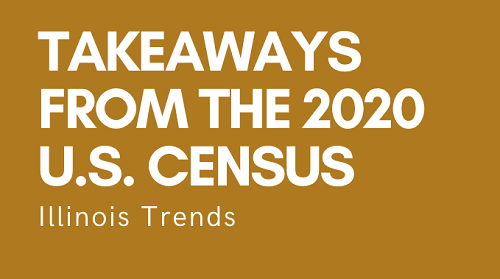Illinois Takeaways from 2020 U.S. Census Findings, Part Three
Published:
August 16, 2021
Data collected for the 2020 U.S. census can reveal important changes in the size, age, distribution, and ethnic and racial makeup of the population in Illinois. This post takes a deeper dive into some of these changes.

Illinois population trends
- All but 14 of the state’s 102 counties lost population in the past decade. That said, eight counties in northeastern Illinois (Cook County, the five suburban “collar” counties, and Grundy and Kendall counties) combined for nearly 149,000 in population growth.
- There were some pockets of downstate growth, with Champaign increasing 8.2% to 88,302, making it one of the state’s 10 most populated cities. Bloomington saw a 2.6% jump to 78,680. Other areas of growth included Carroll, Effingham, Johnson, Monroe, and Williamson counties.
- Several downstate counties experienced population losses of at least 10%, including some in western and southern Illinois. Alexander County at the southwestern tip of the state had the biggest loss, shrinking from 8,238 people to 5,240 (36%).
Illinois age trends
- Since 2010, the population of adults (aged 18 and over) went up 3.1%, an increase of 298,016 people. The population under age 18 decreased 10.1%, for a drop in 316,140 children.
- Kendall County had the highest percent rise (19.4%) in adults, an increase of 15,285 people. Alexander County had the highest percentage drop (33.3%), a decrease of 2,115 people.
- Johnson County has the highest percentage of adults at 82.6%, while Kendall County has the lowest percentage with 71.2%.
Illinois race and ethnicity trends
- The chance that two Illinois people chosen at random are from different racial and ethnic groups increased from 54.7% in 2010 to 60.3% in 2020. (The Census Bureau calls this the Diversity Index.)
- The Black or African American population in Illinois decreased by 3.1% between 2010 and 2020. The White population decreased even more, by 14.3%. However, the Asian population increased by 28.6%, and the Hispanic or Latino population increased by 15.3%.
Chicago area trends
- Chicago remains the third largest city in the United States, growing nearly 2% from 2010 to 2020, from 2.6 million to 2.7 million residents. That’s a change from the population decline the city experienced from 2000 to 2010, when the city lost nearly 7% of its population. That said, among the nation’s 10 largest cities, Chicago’s growth was the smallest at 1.9%.
- Growth in the Chicago suburbs has slowed significantly. The six-county region grew to 8,445,866 people, a 1.6% increase over a decade ago.
- Aurora remains the second-largest city in Illinois, but it saw a marked drop in population, falling from about 198,000 in 2010 to about 181,000 in 2020. With more than 150,000 residents, Joliet has overtaken Rockford as the state’s third-largest city. Naperville is fourth, and Rockford slid to fifth.
- Kendall County, about 50 miles southwest of Chicago, was the state’s fastest-growing county, with a 15% rise in population.
Additional resources
- 2020 Census Results
- 2020 Census Demographic Data Map Viewer
- Race and Ethnicity in the United States: 2010 Census and 2020 Census
- 2020 Census Statistics Highlight Local Population Changes and Nation’s Racial and Ethnic Diversity (U.S. Census Bureau)
- More Than Half of U.S. Counties Were Smaller in 2020 Than in 2010 (American Counts: Stories Behind the Numbers, U.S. Census Bureau)
- Risk of undercounting young children map from the U.S. Population Bureau. This interactive map (developed by the CUNY Mapping Service at the City University of New York’s Graduate Center) shows the risk of undercounting young children across U.S. census tracts in 689 large counties.